St Helena: Difference between revisions
| (One intermediate revision by the same user not shown) | |||
| Line 120: | Line 120: | ||
==Transport== | ==Transport== | ||
[[File:RMS St Helena.jpg|thumb|right|250px|RMS ''St Helena'' in James Bay]] | [[File:RMS St Helena.jpg|thumb|right|250px|RMS ''St Helena'' in James Bay]] | ||
St Helena is one of the most remote islands in the world, currently has no commercial airports, and travel to the island is by ship only. A large military airfield is located on [[Ascension Island]], with two Friday flights to RAF Brize Norton in Oxfordshire (as from September 2010). These RAF flights offer a limited number of seats to civilians. The Royal Mail ship RMS ''St Helena'' runs between St Helena and Cape Town, also visiting Ascension and Walvis Bay, and occasionally voyaging north to Tenerife and the Isle of Portland in Dorset. It berths in James Bay, St Helena about thirty times a year.<ref>[http://www.rms-st-helena.com/voyageschedules.php RMS St Helena Voyage Schedules]</ref> The RMS ''St Helena'' was due for decommissioning in 2010, however its service life has been extended indefinitely until the airstrip is completed. | St Helena is one of the most remote islands in the world, currently has no commercial airports, and travel to the island is by ship only. A large military airfield is located on [[Ascension Island]], with two Friday flights to [[RAF Brize Norton]] in [[Oxfordshire]] (as from September 2010). These RAF flights offer a limited number of seats to civilians. The Royal Mail ship RMS ''St Helena'' runs between St Helena and Cape Town, also visiting Ascension and Walvis Bay, and occasionally voyaging north to Tenerife and the Isle of Portland in Dorset. It berths in James Bay, St Helena about thirty times a year.<ref>[http://www.rms-st-helena.com/voyageschedules.php RMS St Helena Voyage Schedules]</ref> The RMS ''St Helena'' was due for decommissioning in 2010, however its service life has been extended indefinitely until the airstrip is completed. | ||
After a long period of rumour and consultation, the British Government announced plans to build an airport in St Helena in March 2005 and the airport was originally expected to be completed by 2010, but it has been delayed, most recently by the financial crisis. On 22 July 2010, the British Government agreed to help pay for the new airstrip using tax-payers' money.<ref>[http://www.telegraph.co.uk/news/worldnews/africaandindianocean/sainthelena/7905386/Britain-to-pay-for-St-Helena-airstrip-backed-by-Lord-Ashcroft.html St Helena to get airstrip]</ref> | After a long period of rumour and consultation, the British Government announced plans to build an airport in St Helena in March 2005 and the airport was originally expected to be completed by 2010, but it has been delayed, most recently by the financial crisis. On 22 July 2010, the British Government agreed to help pay for the new airstrip using tax-payers' money.<ref>[http://www.telegraph.co.uk/news/worldnews/africaandindianocean/sainthelena/7905386/Britain-to-pay-for-St-Helena-airstrip-backed-by-Lord-Ashcroft.html St Helena to get airstrip]</ref> | ||
| Line 174: | Line 174: | ||
* [http://www.news.co.sh/ St Helena Herald] | * [http://www.news.co.sh/ St Helena Herald] | ||
* [http://www.clickonsthelena.com/ Clickonsthelena.com] | * [http://www.clickonsthelena.com/ Clickonsthelena.com] | ||
* [http:// | * [http://sainthelenaisland.info St Helena Island Info] | ||
* [http://www.sthelena.se/ The first website on St Helena — since 1995] | * [http://www.sthelena.se/ The first website on St Helena — since 1995] | ||
* [http://www.fosh.org.uk/ The Friends of St Helena – a UK society] | * [http://www.fosh.org.uk/ The Friends of St Helena – a UK society] | ||
* [http://www.st-helena.org/ The St Helena Institute – Dedicated to St Helena and Dependencies research since 1997] | * [http://www.st-helena.org/ The St Helena Institute – Dedicated to St Helena and Dependencies research since 1997] | ||
* [http://maps.google.com/maps?f=q&source=s_q&sll=-7.936836,-14.401703&sspn=1.126175,1.400757&ie=UTF8&ll=-15.933352,-5.699759&spn=0.068337,0.087547&t=h&z=14 Google Satellite View | * [http://maps.google.com/maps?f=q&source=s_q&sll=-7.936836,-14.401703&sspn=1.126175,1.400757&ie=UTF8&ll=-15.933352,-5.699759&spn=0.068337,0.087547&t=h&z=14 Google Satellite View] | ||
* [http://news.bbc.co.uk | * [http://news.bbc.co.uk/2/hi/uk_news/magazine/8465785.stm BBC News: Life on one of the world's most remote islands] | ||
* [http://www.sthelenaassociation.org.uk/ A UK based charity established over 40 years. Organisers of Reading Sports Day, Dances and other events] | * [http://www.sthelenaassociation.org.uk/ A UK based charity established over 40 years. Organisers of Reading Sports Day, Dances and other events] | ||
Latest revision as of 15:11, 17 March 2020
| St Helena | |
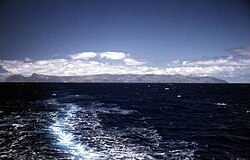 St Helena | |
|---|---|
| Location | |
| Location: | 15°55’60"S, 5°43’0"W |
| Area: | 47 sq miles |
| Data | |
| Population: | 4,255 (February 2008) |
St Helena is an island of volcanic origin in the South Atlantic Ocean. It is part of the British overseas territory of St Helena, Ascension and Tristan da Cunha. The island was named by its Portuguese discoverer after Saint Helena of Constantinople.
St Helena has a population of 4,255. It rises sheer out of the ocean, a cleft in the cliffs giving a place for its chief town (and the territory’s capital) Jamestown.
The island was uninhabited when discovered by the Portuguese in 1502. It is one of the most isolated islands in the world. For centuries, it was an important stopover for ships sailing to Europe from Asia and South Africa. Britain also used the island as a place of exile, most notably for Napoleon I, Dinuzulu kaCetshwayo King of the Zulus and more than 5,000 prisoners of the Boer War. St Helena is now Britain's oldest remaining colony after Bermuda.
Geography, flora and fauna
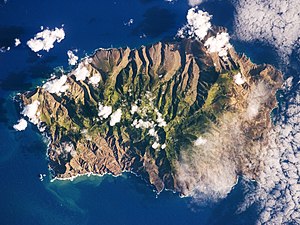
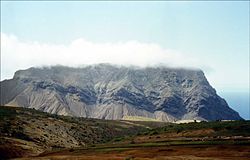
St Helena is one of the most isolated places in the world, located in the South Atlantic Ocean more than 1,200 miles from the nearest major landmass. Even its fellow islands, Ascencion and Tristan da Cunha, lie 810 miles and 1,510 miles away to the northwest and south respectively.
St Helena has a total area of 47 square miles and is composed largely of rugged terrain of volcanic origin, though the last volcanic eruptions occurred roughly 7 million years ago.[1] The centre is covered by forest, of which some has been planted, including the New Millennium Forest Project. The highland areas contain most of the island's endemic flora, fauna, insects and birds. The coastal areas are barren, covered in volcanic rock and are warmer and drier than the centre of the island.
The highest point of the island is Diana's Peak at 2,684 feet.
There are several rocks and islets off the coast, including: Castle Rock, Speery Island, The Needle, Lower Black Rock, Upper Black Rock (south), Bird Island (southwest), Black Rock, Thompson's Valley Island, Peaked Island, Egg Island, Lady's Chair, Lighter Rock (west), Long Ledge (northwest), Shore Island, George Island, Rough Rock Island, Flat Rock (east), The Buoys, Sandy Bay Island, The Chimney, White Bird Island and Frightus Rock (southeast), all of which are within a mile of the shore.
There are no native land mammals on St Helena, but rabbits, rats and mice have been introduced, as well as feral cats and dogs.
When the island was discovered, it was covered with unique indigenous vegetation, including a remarkable cabbage tree species. The flora of St Helena contains a high proportion of endemic species. The island's hinterland must have been a dense tropical forest but the coastal areas were probably quite green as well. The modern landscape is very different, with widespread bare rock in the lower areas, although inland it is green, mainly due to introduced vegetation. The dramatic change in landscape must be attributed to the introduction of goats and the introduction of new vegetation. As a result, the string tree (Acalypha rubrinervis) and the St Helena olive (Nesiota elliptica) are now extinct, and many of the other endemic plants are threatened with extinction.
Climate
The climate of St Helena is tropical, marine and mild, tempered by trade winds which blow almost continuously.[2] The climate varies noticeably across the island. Temperatures in Jamestown, on the northern, leeward shore, range between 20 - 32 ºC in the summer and 15 – 26 ºC in the winter. The temperatures in the central areas are, on average, 5–6 °C lower.[2] Jamestown also has a very low annual rainfall compared with the higher ground and the south coast.[3]
Churches
The island falls within the Diocese of St Helena within the Anglican Church of Southern Africa and the majority of people belong to this church. The 150th Anniversary of the Diocese was celebrated in June 2009.
There are three Parishes on Saint Helena with 12 churches:
- St Paul's Cathedral Parish which consists of St Paul's Cathedral, and four daughter churches:
- St Andrew's, Half Tree Hollow
- St Helena of the Cross, Blue Hill
- St Martin's in the Hills, Thompsons Hill
- St Peter's, Sandy Bay
- The Parish of St James. St James' Church in Jamestown is the oldest Anglican Church in the southern hemisphere, the present building was put up in 1774. There are 3 daughter churches:
- St John's, Upper Jamestown
- St Mary's, the Briars
- St Michael's, Ruperts Valley
- The Parish of St Matthew, Hutts Gate with one daughter church,
- St Mark's, Longwood
- a congregation at Levelwood but no church
Other Christian denominations represented on the island include Baptist (since 1845), Roman Catholic (since 1852), Salvation Army (since 1886) and since more recent times Seventh-day Adventists (since 1949), New Apostolic and Jehovah's Witness (one out of every 35 residents is a Jehovah's Witness, the highest ratio in the world).[4] The Baha'i Faith has been represented on the island since 1954.
History
Early history, 1502–1658
Most historical accounts state that the island was discovered on 21 May 1502 by the Galician navigator João da Nova sailing at the service of the Portuguese Crown, and that he named it "Santa Helena" after Helena of Constantinople. It has also been suggested by reputable scholars,[5][6][7] however, that the island found by De Nova was actually Tristan da Cunha and that St Helena was discovered by some of the ships attached to the squadron of the Estêvão da Gama expedition on 30 July 1503 (as reported in the account of clerk Thomé Lopes).[5][6][7]
The Portuguese found the island uninhabited, with an abundance of trees and fresh water. They imported livestock, fruit trees and vegetables, and built a chapel and one or two houses. Though they formed no permanent settlement, the island was an important rendezvous point and source of food for ships travelling from Asia to Europe.
Sir Francis Drake probably located the island on the final lap of his circumnavigation of the world (1577–1580).[8] Further visits by other English explorers followed, and, once St Helena’s location was more widely known, English ships of war began to lie in wait in the area to attack Portuguese India carracks on their way home. In developing their Far East trade, the Dutch also began to frequent the island. The Portuguese and Spanish soon gave up regularly calling at the island, partly because they used ports along the West African coast, but also because of attacks on their shipping, the desecration of their chapel and religious icons, destruction of their livestock and destruction of plantations by Dutch and English sailors. The Dutch Republic formally made claim to St Helena in 1633, although there is no evidence that they ever occupied, colonised or fortified it. By 1651, the Dutch had mainly abandoned the island in favour of their colony at the Cape of Good Hope.
East India Company, 1658–1815
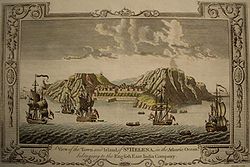
In 1657, Oliver Cromwell,[9] granted the English East India Company a charter to govern St Helena and the following year the Company decided to fortify the island and colonise it with planters. The first governor, Captain John Dutton, arrived in 1659. A fort and houses were built. After the restoration of the English monarchy in 1660, the East India Company received a Royal Charter giving it the sole right to fortify and colonise the island. The fort was renamed James Fort and the town Jamestown, in honour of the Duke of York, later King James II.
The Company experienced difficulty attracting new immigrants, and unrest and rebellion fomented among the inhabitants. Ecological problems, including deforestation, soil erosion, vermin and drought, led the Governor Isaac Pyke to suggest in 1715 that the population be moved to Mauritius, but this was not acted upon and the Company continued to subsidise the community because of the island's strategic location. A census in 1723 recorded 1,110 people, including 610 slaves.
Eighteenth-century governors tried to tackle the island's problems by extending tree plantations, improving fortifications, eliminating corruption, building a hospital, tackling the neglect of crops and livestock, controlling the consumption of alcohol and introducing legal reforms. From about 1770, the island enjoyed a lengthy period of prosperity. A church was erected in Jamestown in 1774. Captain James Cook visited the island in 1775 on the final leg of his second circumnavigation of the world.
The importation of slaves was made illegal in 1792. Governor Robert Patton (1802–1807) recommended that the Company import Chinese labour to supplement the rural workforce. The labourers arrived in 1810, and their numbers reached 600 by 1818. Many were allowed to stay, and their descendents became integrated into the population. An 1814 census recorded 3,507 people on the island.
British rule 1815–1821, and Napoleon's exile
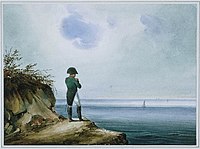
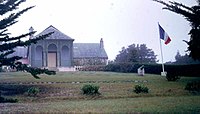
In 1815 the British government selected St Helena as the place at which Napoleon Bonaparte, the deposed, defeated French Emperor, would be detained. He was brought to the island in October 1815 and lodged at Longwood, where he died on 5 May 1821. During this period, St Helena remained in the East India Company’s possession, but the British government met additional costs arising from guarding Napoleon. The island was strongly garrisoned with British troops, and naval ships circled the island.
The 1817 census recorded 821 white inhabitants, a garrison of 820 men, 618 Chinese indentured labourers, 500 free blacks and 1,540 slaves. In 1818, Governor Lowe initiated the emancipation of the slaves.
British East India Company, 1821–1834
After Napoleon's death the thousands of temporary visitors were soon withdrawn and the East India Company resumed full control of St Helena. Owing to Napoleon's praise of St Helena’s coffee during his exile on the island, the product enjoyed a brief popularity in Paris in the years after his death. In 1832, the East India Company abolished slavery in St Helena (freeing 614 slaves), a year before legislation to ban slavery in the colonies was passed by Parliament.
British rule, a Crown colony, 1834–1981
Under the provisions of the 1833 India Act, control of St Helena was passed from the East India Company to the British Crown. Subsequent administrative cost-cutting triggered the start of a long-term population decline whereby those who could afford to do so tended to leave the island for better opportunities elsewhere. The latter half of the 19th century saw the advent of steam ships not reliant on trade winds, as well as the diversion of Far East trade away from the traditional South Atlantic shipping lanes to a route via the Red Sea (which, prior to the building of the Suez Canal involved a short overland section). These factors contributed to a decline in the number of ships calling at the island from 1,100 in 1855 to only 288 in 1889.
In 1840, a British naval station established to suppress the African slave trade was based on the island, and between 1840 and 1849 over 15,000 freed slaves, known as "Liberated Africans" were landed there. In 1900 and 1901, over six thousand Boer prisoners were held on the island, and the population reached its all-time high of 9,850 in 1901.
A local industry manufacturing fibre from New Zealand flax was successfully re-established in 1907 and generated considerable income during the First World War. Ascension Island was made a dependency of St Helena in 1922, and Tristan da Cunha followed in 1938. During the early twentieth century the island enjoyed increased revenues through the sale of flax, with prices peaking in 1951. However, the industry declined because of transportation costs and competition from synthetic fibres. The decision by the British Post Office to use synthetic fibres for their mailbags was a further blow, contributing to the closure of the island's flax mills in 1965.
From 1958, the Union Castle shipping line gradually reduced its service calls to the island. Curnow Shipping, based in Avonmouth, replaced the Union-Castle Line mailship service in 1977, using the Royal Mail Ship St Helena. In 1989, Prince Andrew launched the replacement RMS St Helena to serve the island; the vessel was specially built for the Cardiff–Cape Town route and features a mixed cargo/passenger layout.
1981 to present
The British Nationality Act 1981 reclassified St Helena and the other Crown colonies as British Dependent Territories. The islanders lost their status as "Citizens of the United Kingdom and Colonies" and thus lost the right of abode in Britain. For the next 20 years until the British Overseas Territories Act 2002 restored full citizenship to the islanders, many could find only low-paid work with the island government, and the only available overseas employment was on the Falkland Islands and Ascension Island. The Development and Economic Planning Department, which still operates, was formed in 1988 to contribute to raising the living standards of the people of St Helena.
People
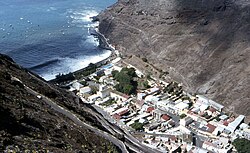
St Helena was first settled by the English in 1659, and the island presently has a population of about 4,250 inhabitants, mainly descended from people from Britain – settlers ("planters") and soldiers – and slaves who were brought there from the beginning of settlement – initially from Africa (the Cape Verde Islands, Gold Coast and west coast of Africa are mentioned in early records), then India and Madagascar. Eventually the planters felt there were too many slaves and no more were imported after 1792.
In 1840, St Helena became a provisioning station for the British West Africa Squadron suppressing slave trading to Brazil, and many thousands of slaves were freed on the island. These were all African, and about 500 stayed while the rest were sent on to the West Indies and Cape Town, and eventually to Sierra Leone.
Imported Chinese labourers arrived in 1810, reaching a peak of 618 in 1818, after which numbers were reduced. Only a few older men remained after the British Crown took over the government of the island from the East India Company in 1834. The majority were sent back to China, although records in the Cape suggest that they never got any further than Cape Town. There were also a very few Indian lascars who worked under the harbour master.
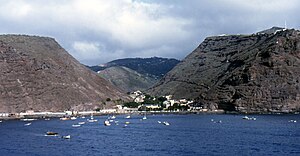
The citizens of St Helena hold British Overseas Territories citizenship. On 21 May 2002, full British citizenship was restored by the British Overseas Territories Act 2002.[10]
During periods of unemployment, there has been a long pattern of emigration from the island since the post-Napoleonic period. The majority of "Saints" emigrated to the UK, South Africa, and in the early years, Australia. The population has steadily declined since the late 1980s and has dropped from 5,157 at the 1998 census to 4,255 in 2008. In the past emigration was characterised by young unaccompanied persons leaving to work on long-term contracts on Ascension and the Falkland Islands, but since "Saints" were re-awarded British citizenship in 2002, emigration to the UK by a wider range of wage-earners has accelerated due to the prospect of higher wages and better progression prospects.
Economy
The island had a monocrop economy until 1966, based on the cultivation and processing of New Zealand flax for rope and string. St Helena's economy is now very weak, and the island is almost entirely sustained by aid from London. The public sector dominates the economy, accounting for about half of GDP. Inflation was running at 3.6% in 2005 but is thought to be much higher today, reflecting recent increases in the cost of fuel, power and all imported goods.
The St Helena tourist industry is heavily based on the promotion of Napoleon's imprisonment. A golf course also exists and the possibility for sport fishing tourism is great. Three hotels operate on the island but since the arrival of tourists is directly linked to the arrival and departure schedule of the Royal Mail Ship, occupancy levels are very low at about 10%. Some 1,180 short- and long-term visitors arrived on the island in 2005.
St Helena produces what is said to be the most expensive coffee in the world. It also produces and exports Tungi Spirit, made from the fruit of the prickly or cactus pears, Opuntia ficus-indica ("Tungi" is the local St Helenian name for the plant). Ascension Island, Tristan da Cunha and St Helena all issue their own postage stamps which provide a significant income.
Transport
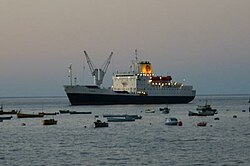
St Helena is one of the most remote islands in the world, currently has no commercial airports, and travel to the island is by ship only. A large military airfield is located on Ascension Island, with two Friday flights to RAF Brize Norton in Oxfordshire (as from September 2010). These RAF flights offer a limited number of seats to civilians. The Royal Mail ship RMS St Helena runs between St Helena and Cape Town, also visiting Ascension and Walvis Bay, and occasionally voyaging north to Tenerife and the Isle of Portland in Dorset. It berths in James Bay, St Helena about thirty times a year.[11] The RMS St Helena was due for decommissioning in 2010, however its service life has been extended indefinitely until the airstrip is completed.
After a long period of rumour and consultation, the British Government announced plans to build an airport in St Helena in March 2005 and the airport was originally expected to be completed by 2010, but it has been delayed, most recently by the financial crisis. On 22 July 2010, the British Government agreed to help pay for the new airstrip using tax-payers' money.[12]
A minibus offers a basic service to carry people around St Helena, with most services designed to take people into Jamestown for a few hours on weekdays to conduct their business.
Local newspapers
The island has two local newspapers, both of which are available on the internet. The St Helena Herald[13] has been published by the partially publicly funded St Helena News Media Services (SHNMS) since 2000. The St Helena Independent[14] has been published since November 2005.
Culture and society
Education is free and compulsory between the ages of 5 and 15. There is no tertiary education institution in St Helena.
St Helena is a member of the International Island Games Association. The St Helena cricket team is due to make its debut in international cricket in Division Three of the African region of the World Cricket League in 2011.
See also
References
- ↑ Natural History of St Helena
- ↑ 2.0 2.1 About St Helena, St Helena News Media Services
- ↑ BBC Weather Centre
- ↑ Watchtower.org
- ↑ 5.0 5.1 A.H. Schulenburg, 'The discovery of St Helena: the search continues'. Wirebird: The Journal of the Friends of St Helena, Issue 24 (Spring 2002), pp. 13–19.
- ↑ 6.0 6.1 Duarte Leite, História dos Descobrimentos, Vol. II (Lisbon: Edições Cosmos, 1960), 206.
- ↑ 7.0 7.1 de Montalbodo, Paesi Nuovamente Retovati & Nuovo Mondo da Alberico Vesputio Fiorentino Intitulato (Venice: 1507).
- ↑ Drake and St Helena, privately published by Robin Castell in 2005
- ↑ History: St Helena homepage
- ↑ St Helena celebrates the restoration of full citizenship, Telegraph, 22 May 2002
- ↑ RMS St Helena Voyage Schedules
- ↑ St Helena to get airstrip
- ↑ News.co.sh
- ↑ Saint.fm
Further reading
- Gosse, Philip St Helena, 1502–1938 ISBN 0-904614-39-5
- Smallman, David L., Quincentenary, a Story of St Helena, 1502–2002 ISBN 1-87229-47-6
- Jackson, E. L. St Helena: The Historic Island, Ward, Lock & Co, London, 1903
- Cannan, Edward Churches of the South Atlantic Islands 1502–1991 ISBN 0-904614-48-4
- George, Barbara B. St Helena — the Chinese Connection (2002) ISBN 1-899489-22
- Cross, Tony St Helena including Ascension Island and Tristan Da Cunha ISBN 0-7153-8075-3
- Brooke, T. H., A History of the Island of St Helena from its Discovery by the Portuguese to the Year 1806”, Printed for Black, Parry and Kingsbury, London, 1808
- Hakluyt, The Principal Navigations Voyages Traffiques & Discoveries of the English Nation, from the Prosperous Voyage of M. Thomas Candish esquire into the South Sea, and so around about the circumference of the whole earth, begun in the yere 1586, and finished 1588, 1598–1600, Volume XI.
- Darwin, Charles, Geological Observations on the Volcanic Islands, Chapter 4, Smith, Elder & Co., London, 1844.
- Duncan, Francis, A Description of the Island Of St Helena Containing Observations on its Singular Structure and Formation and an Account of its Climate, Natural History, and Inhabitants, London, Printed For R Phillips, 6 Bridge Street, Blackfriars, 1805
- Janisch, Hudson Ralph, Extracts from the St Helena Records, Printed and Published at the “Guardian” Office by Benjamin Grant, St Helena, 1885
- Van Linschoten, Iohn Huighen, His Discours of Voyages into ye Easte & West Indies, Wolfe, London, 1598
- Melliss, John C. M., St Helena: A Physical, Historical and Topographical Description of the Island Including Geology, Fauna, Flora and Meteorology, L. Reeve & Co, London, 1875
- Schulenburg, A. H., St Helena Historiography, Philately, and the "Castella" Controversy”, South Atlantic Chronicle: The Journal of the St Helena, Ascension and Tristan da Cunha Philatelic Society, Vol.XXIII, No.3, pp. 3–6, 1999
- Bruce, I. T., Thomas Buce: St Helena Postmaster and Stamp Designer, Thirty years of St Helena, Ascension and Tristan Philately, pp 7–10, 2006, ISBN 1-890454-37-0
- Crallan, Hugh, Island of St Helena, Listing and Preservation of Buildings of Architectural and Historic Interest, 1974
- Kitching, G. C., A Handbook of St Helena Including a short History of the island Under the Crown
- Eriksen, Ronnie, St Helena Lifeline, Mallet & Bell Publications, Norfolk, 1994, ISBN 0-620-15055-6
- Denholm, Ken, South Atlantic Haven, a Maritime History for the Island of St Helena, published and printed by the Education Department of the Government of St Helena
- Evans, Dorothy, Schooling in the South Atlantic Islands 1661–1992, Anthony Nelson, 1994, ISBN 0-904614-51-4
- Hibbert, Edward, St Helena Postal History and Stamps”, Robson Lowe Limited, London, 1979
- Chaplin, Arnold, A St Helena's Who's Who or a Directory of the Island During the Captivity of Napoleon, published by the author in 1914. This has recently been republished under the title Napoleon’s Captivity on St Helena 1815–1821, Savannah Paperback Classics, 2002, ISBN 1-902366-12-3
- Holmes, Rachel: Scanty Particulars: The Scandalous Life and Astonishing Secret of James Barry, Queen Victoria's Most Eminent Military Doctor, Viking Press, 2002, ISBN 0-375-5055-6
- Shine, Ian, Serendipity in St Helena, a Genetical and medical Study of an isolated Community, Pergamon Press, Oxford, 1970 ISBN 0-0801-2794-0
- Dampier, William, Piracy, Turtles & Flying Foxes, 2007, Penguin Books, 2007, pp 99–104, ISBN 0-1410-2541-4
- Clements, B.; "St Helena:South Atlantic Fortress"; Fort, (Fortress Study Group), 2007 (35), pp75–90
Outside links
- The Official Government Website of St Helena
- St Helena Travel Guide from Travellerspoint
- The Official Website for St Helena Tourism
- St Helena Herald
- Clickonsthelena.com
- St Helena Island Info
- The first website on St Helena — since 1995
- The Friends of St Helena – a UK society
- The St Helena Institute – Dedicated to St Helena and Dependencies research since 1997
- Google Satellite View
- BBC News: Life on one of the world's most remote islands
- A UK based charity established over 40 years. Organisers of Reading Sports Day, Dances and other events
